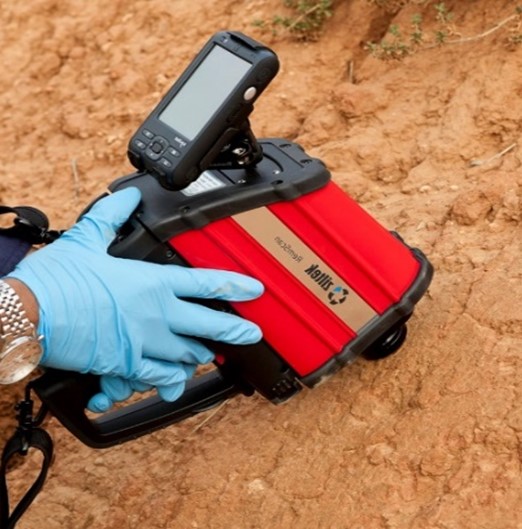Promoting advanced PFAS leaching assessment tools in Australia
Promoting advanced PFAS leaching assessment tools in Australia
Our international team is developing and refining methods to better understand how PFAS behave and leach from impacted materials using both standardised leach testing and emerging tools.
Standardised leach testing
With support from the U.S. Strategic Environmental Research and Development Program (SERDP), our international team optimised and demonstrated existing standard leaching methods for use in assessing PFAS leaching and mobility.
The Leaching Environmental Assessment Framework (LEAF) provides a scientific basis for evaluating how contaminants are released from soils, biosolids, and other materials under variable environmental conditions. Originally developed for inorganic constituents, Vanderbilt University in conjunction with the project team and the United States Environmental Protection Agency (USEPA) has updated LEAF methods to include per- and polyfluoroalkyl substances (PFAS) and semi-volatile organic compounds (SVOCs).
The modified LEAF methods (Draft EPA Methods 1313A–1316A; Table 1) account for the unique challenges of analysing organics such as PFAS — including background contamination, sorption effects, and handling of eluates. Together, they provide a standardised approach for assessing contaminant leachability and supporting remediation, reuse, and regulatory decisions.
Table 1. EPA SW-846 methods that comprise the LEAF framework.
| Method | Description |
| 1313 | Liquid-solid partitioning as a function of extract pH using a parallel batch extraction (i.e. equilibrium) procedure |
| 1314 | Liquid-solid partitioning as a function of liquid-solid ratio for constituents in solid materials using an up-flow percolation column procedure |
| 1315 | Mass transfer rates of constituents in monolithic or compacted granular materials using a semi-dynamic tank leaching procedure |
| 1316 | Liquid-solid partitioning as a function of liquid-solid ratio using a parallel batch extraction (i.e. equilibrium) procedure |
Text shown in bold indicates primary condition evaluated in each method.
The modified LEAF methods help to:
- Enable parallel assessment of PFAS, SVOC and inorganic constituents of potential concern leaching allowing a more comprehensive evaluation of contaminant release from soils, biosolids, and industrial by-products;
- Assess the effectiveness of treatment and remediation technologies;
- Support risk-based decisions for reuse and site management; and
- Promote consistency in PFAS testing across laboratories and jurisdictions.
By providing a flexible, standardised framework, LEAF improves understanding of contaminant mobility and long-term release potential.
Emerging tools

Mid-infrared (MIR) spectroscopy
Alongside the validation and application of LEAF methods for PFAS, CSIRO and the University of Adelaide led efforts to explore mid-infrared (MIR) spectroscopy as a rapid, integrative tool for assessing PFAS behaviour in soils. By characterising AFFF-impacted media using MIR spectroscopy, the team developed proof-of-concept models linking MIR spectra with sorption and leaching data.
Developed in collaboration with Texas Tech University and Vanderbilt University, these MIR-based models demonstrated the potential to predict PFAS sorption (Kd) and leachability from impacted soils. While further calibration data are needed to improve model robustness, the approach shows promise as a complementary tool for evaluating PFAS mobility.
Resources for practitioners
Practitioners and laboratories can access the full EPA Background Information Document (BID), which includes technical details, experimental results, and draft test methods (1313A, 1314A, and 1316A):
Efforts are ongoing to finalise similar guidance for Method 1315A.
Promoting international collaboration
This research is part of an international collaboration funded by SERDP, led by Dr Jennifer Guelfo from Texas Tech University. The project brings together experts from Vanderbilt University, CDM Smith, the University of Adelaide, and others to refine and validate the Leaching Environmental Assessment Framework (LEAF) methods for assessing PFAS and related organic contaminants. The U.S. Environmental Protection Agency (EPA) is supporting the current method validation phase, which will be used to support eventual publication of the modified LEAF methods in USEPA SW-846.
The broader effort involves researchers and laboratories across the United States, Europe, China, Australia, and Israel. We are working collectively to strengthen global understanding of how PFAS move and transform in the environment.
As Australia’s national science agency, CSIRO plays a key role in linking international research to local application. Our work contributes both to method development and to building practical tools for assessing PFAS behaviour. This includes:
- Supporting international validation of the LEAF methods for PFAS and similar compounds;
- Developing complementary predictive tools using MIR spectroscopy to rapidly estimate PFAS mobility in soils; and
- Promoting knowledge exchange to help Australian researchers, laboratories, and regulators adopt advanced leaching assessment approaches.
By combining robust, standardised testing (LEAF) with innovative analytical tools (MIR), CSIRO helps bridge research and practice—ensuring the latest scientific advances can inform real-world PFAS management and remediation in Australia.
Contact Details
For more information about the LEAF methods and emerging tools for assessing PFAS leachability, please contact:

Dr Divina Navarro
- Primary Emaildivina.navarro@csiro.au

Dr Jennifer Guelfo
- Primary Emailjennifer.guelfo@ttu.edu
